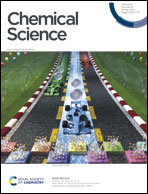Enantioselective construction of cis-hydroindole scaffolds via an asymmetric inverse-electron-demand Diels–Alder reaction: application to the formal total synthesis of (+)-minovincine†
Abstract
cis-Hydroindole scaffolds widely exist in a large number of natural products, pharmaceuticals, and organocatalysts. Therefore, the development of efficient and enantioselective methods for the construction of cis-hydroindoles is of great interest and importance. Herein, a novel approach for the enantioselective synthesis of cis-hydroindole scaffolds has been realized through a chiral N,N′-dioxide/Mg(OTf)2 complex catalyzed asymmetric inverse-electron-demand Diels–Alder (IEDDA) reaction of 2-pyrones and cyclic enamines. A series of substituted cis-hydroindole derivatives bearing multiple contiguous stereocenters and functional groups were obtained in good to excellent yields and enantioselectivities (up to 99% yield, and 95% ee) under mild reaction conditions. Moreover, the enantioselective formal total synthesis of (+)-minovincine was concisely furnished with high efficiency and stereoselectivity to demonstrate the synthetic potential of this method.

- This article is part of the themed collection: 2022 Chemical Science HOT Article Collection


 Please wait while we load your content...
Please wait while we load your content...